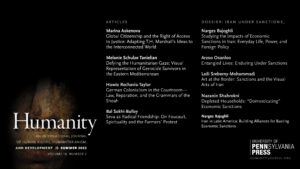Abstract: Amnesty International was born in the highly politicized context of the East-West conflict commonly known as the Cold War with the intention of transcending its fault lines. It developed a politics of impartiality that was however deeply rooted in the Cold War paradigm and followed the example of the Red Cross and its humanitarian activism. These two features impeded organization’s navigation of the fluctuating dynamics between East and West and hampered the emergence of a local membership beyond the Iron Curtain in the 1970s. Despite the fact that Amnesty’s policy of impartiality was in constant flux, it remained ill-adapted to the different circumstances in Eastern Europe.
Current Issue

Our long-awaited issue of Humanity journal is out! Its special dossier, Iran under Sanctions, examines the myriad and devastating impacts of international sanctions on society, culture, and politics. The issue includes an essay on the legal case Herero and Nama v. The Federal Republic of Germany to theorize reparations for German colonialism and slavery as they became linked with the aftermath of the Shoah. It also includes essays on T.H. Marshall and the right of access to justice; visual representations of Armenian genocide survivors; and, the concept of radical friendship in relation to the Farmers’ Protests in India.
View entire issue > Save Save Save
📘'Choose Your Bearing: Édouard Glissant, Human Rights and Decolonial Ethics' is now available for pre-order!
❕Grab your copy and save 30% OFF using the code NEW30 at checkout : https://edin.ac/3JIcRne
@HumanityJ